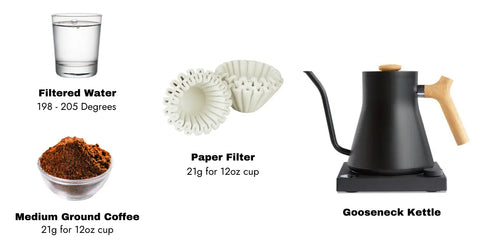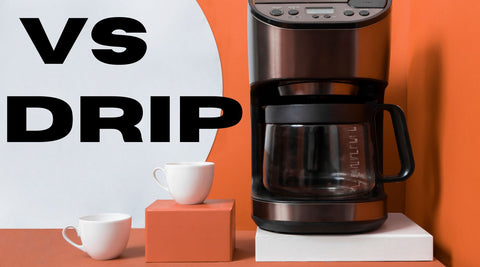How To Make Pour Over Coffee
How To Make The Best Pour-Over Coffee
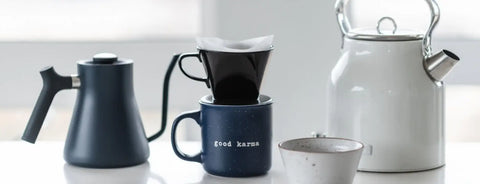
How To Make Pour Over Coffee
When people think about pour-over coffee we are usually left with cinema images of office canteens filled with stale pots of sad brown water that used to resemble brewed coffee, and it is so much more than that.
With the right coffee grounds, a quality pour-over coffee maker such as a Kalita Wave, and of course hot water, you can enjoy filter coffee at its finest.
To brew coffee takes a few trials and errors, and after many sips, you will soon master the brewing process that makes your final cup as close to the coffee shops versions we all know so well.
Why Pour over Brewing is Different
It sounds simple enough to add coffee grounds to a paper filter and add hot water when you first make pour-over coffee, however, as coffee lovers will quickly tell you, the best pour-over coffee comes with practice.
A few elements make this coffee brewing process slightly different from regular methods such as a Chemex or if using traditional tools such as a French press or Aeropress.
Let's take a look at what some of those are and why this technique may just be what you have been waiting for when it comes to making a fuss-free morning cup.
At the end of the day, all we want is to drink coffee and be happy right?
- The pour-over method offers continuously saturated coffee grounds for most of the brewing stage, whereas French press coffee is more of an immersion brewing coffee technique.
- Sometimes we are running late in the morning, it has happened to all of us at one point in our lives, and knowing how to make pour-over coffee will save you that much-needed time and effort without the need to sacrifice not having a brew.
- Another perk is you control the temperature of the water being added and how quickly you add it to the coffee grounds. This allows you to regulate how long of a coffee extraction you want to take place, and how much you want to make, opting for extra to enjoy later as iced coffee.
- You are also in charge of the overall taste and can enjoy a single cup just how you like it according to the brew time and the strength of the type of coffee, unlike what you will get at your local coffee shop.
- Pour-over coffee is also easier on the wallet to make compared to investing in an espresso machine that can do the same thing.
Pour Over Coffee Equipment You Need:
What You Need To Make The Perfect Pour Over Coffee
A few basics and you will be well onto your first pour for the day, and as you become more familiar with the techniques and gauging the time frames and grind size, it will quickly become second nature. Let's see how to make the best pour-over coffee to boost your mood.
How To Make Pour Over Coffee
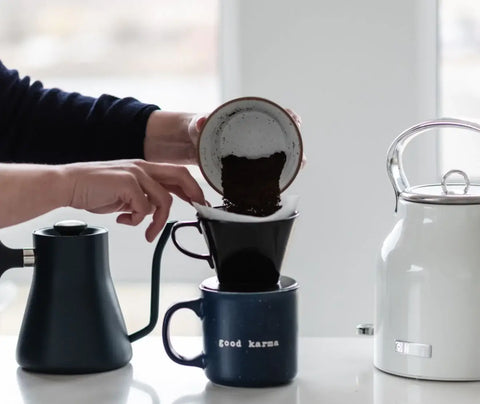
Add Coffee Filter & Grounds
Pour the coffee grounds into the paper filter, don't worry your coffee won't have a paper taste, and place it onto your mug or carafe.
Be sure to shake the coffee grounds so they are evenly dispersed which can be affected during the pouring process as all the grounds may not be equally soaked and it creates an uneven extraction withdrawal.
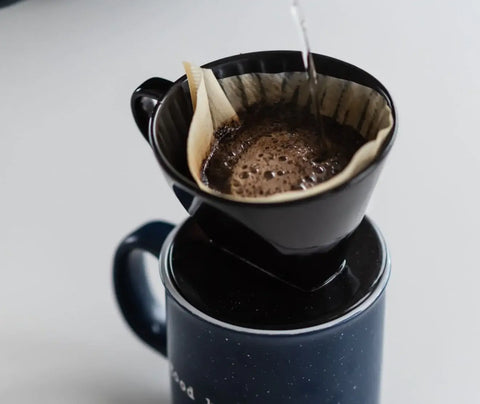
Bloom it. Time it
If you have a scale you can use it here to measure your water. Totally optional, we prefer to free pour! Put your carafe on a zeroed scale and add the boiling water.
This is called the bloom pour.
Where the carbon dioxide is released through the coffee grounds and you begin to see bubbles in the coffee grounds. Pour the water for about 20 seconds, or the equivalent of double the weight of the ground coffee beans. Leave for 45 seconds to 'bloom.'
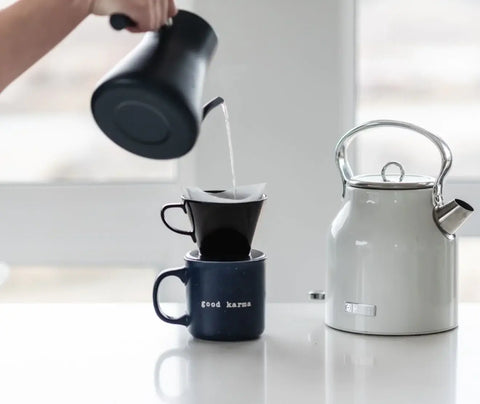
Pour Water
Pour the rest of your water into the carafe and coffee mix in a circular motion to make it absorb evenly. Watch for a slow drip that runs steadily till the vessel is about half full and add the remaining water. Slow down as the level nears the top to prevent an overflow.
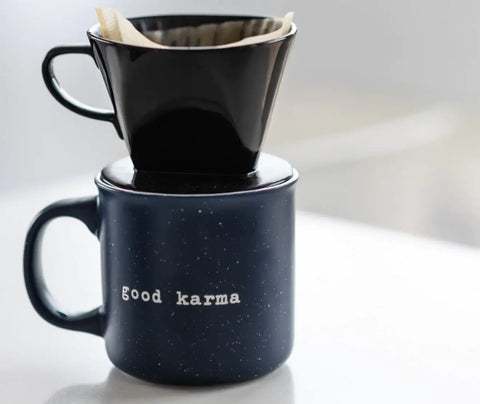
Let Drip
Leave the rest of the water to drip through the coffee, and keep a close eye at around the 2-minute mark. If you see coffee granules in the mix or on the glass remove the filter to the sink and let drip away. The latter part of the procedure can have bitter flavors if left to extract for too long, not something you want.
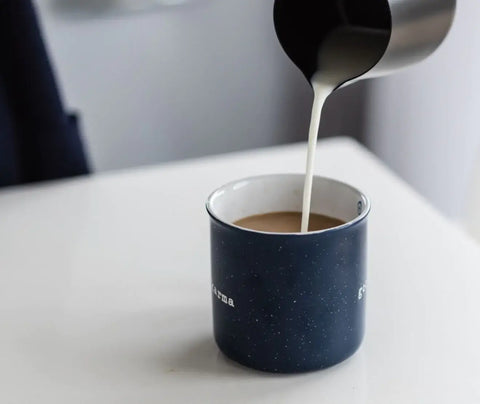
Drink Up
Now comes the best part. Serve your freshly brewed coffee straight from the carafe into your blue bottle thermos, or let cool slightly if you made it directly into a mug. Feel free to add a biscuit nibble on the side, because we all deserve a biscuit don't we?
A Last Word On Pour Overs
Whether you have invested in a chic gooseneck kettle to add to your coffee-making arsenal for a more steady stream and consistent pour when enjoying your morning cuppa, or you are working with the basics, there is always a way to make great-tasting coffee. The fundamentals are the same, knowing how much coffee per cup or considering the water-to-coffee ratio can have very different tasting brews, but if you have a top quality bean you can't go too wrong. Your brew device is a starting point at which the other components play major roles in.
Coffee Questions:
Have more questions about pour over coffee?What is the difference between pour over and drip coffee?
There are a few significant differences between the two, listed below are what we feel makes the most impact on the decision-making process when looking at both options.
Quality - Pour over coffee offers a higher quality brew and a wider variations menu when creating coffee drinks. A drip version does, however, give you the consistency of a good sip, but why settle for good when you can have great? You always want to pay a bit more for great coffee beans that have been harvested ethically and organically and live up to their price tag. A cheaper bean will be tasted immediately.
Flavor - The extended period of the brewing water means pour-over is the better choice, the flavor draws out for longer, including the oils that are often blocked by paper coffee filters in drip coffee machines.
Consistency and convenience - After making a pour-over brew having a quick look at the coffee bed can tell you whether your grind size is correct or too fine (resembling fine sea salt), thus pour over coffee offers more control. But it is not the best when it comes to consistency time and again. Drip-style uses the same coffee grounds and hot water, the same paper coffee filter, and you get the same generic taste. For this sake, it has better consistency and you don't have to watch it like a hawk, but I prefer a better-tasting cup over the same old one.
What grinds for pour over coffee?
Ground coffee as we know comes in all shapes and sizes, and while many people may not realize it or even believe it, it can have a big impact on how your cup of pour-over coffee tastes and feels in your mouth. If you have made a coffee and are not sure why the taste is not quite right you need to look at the coffee bed, if the grounds are clinging up the wall of the basket or filter, your grind size was too fine.
Pour-over drinks do best when using a medium, coarser grind which is effortless to achieve if you have an electric burr grinder on hand. Grinding can be labor intensive and investing in a good burr grinder can make for light work.
Grind size is something to keep in mind when searching for the perfect cup of craft coffee, but the quality of ingredients is the most important element
Is pour over stronger than drip coffee?
When comparing pour-over brewers to generic, somewhat traditional dripping-style coffee percolators, you would think the coffee would result in a more intense, stronger profile, but this is not so.
Rather, because a pour-over brewer requires a longer extraction method, the brewing water has more time to draw out the oils and flavors from the coffee grounds so it is a more aromatic, flavorful drink.
When made by barista masters and coffee enthusiasts who have had their fair share of drinking coffee, you could certainly take high-quality ingredients or your favorite medium roast ground coffee blend, and create a decent craft coffee using a pour-over brewer.
Why does my pour-over coffee taste bitter?
The last thing anyone wants is to look forward to a crema-topped cup of java first thing in the morning only to be greeted by a bitter-tasting, over-extracted, cup of brew. No thank you.
By over-extracting during the brewing stages, it means that you have dissolved more flavors and organic compounds than you intended to. Coffee grounds also have a limit during the roasting process but thankfully pour-over brewers make it simple to regulate and this is easily preventable.

